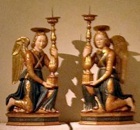Room 18
This room, the Sala della Congregazione Governativa, probably formed part of the extension to the palace instituted by a series of papal governors after their earlier residence, the ex-Palazzo del Podestà, was burned down in the rebellion of 1534. Cardinal Tiberio Crispo commissioned the frescoed frieze around the upper part of the room in 1545-8 (see below).
This room now features an exhibition of tablecloths (mostly 15th century) of local manufacture, together with a few free-standing works of art that include such cloths as part of their composition.
Adoration of the shepherds (1476-7)

This altarpiece was recorded in 1784 in Santa Maria di Monteluce, above the grill in the nuns' choir through which they took Communion. It was then attributed to Fiorenzo di Lorenzo but more recently has been linked to the payments that the nuns made to Bartolomeo Caporali in 1476-9.
-
✴The main panel (illustrated above) depicts the three kings (and their bedraggled dog) paying homage to the baby Jesus, who lies naked on the ground between His parents. Musical angels fill the stable behind, while the evicted animals look on. The scene is set in a rocky landscape, and the angels bring the news to shepherds on outcrops to the right and left.
-
✴The predella depicts the following saints in small tondi: SS Michael, Bernardino of Siena, Louis of Toulouse, Clare, Antony of Padua (who holds his tongue, which was found to be uncorrupted when his relics were translated in 1263) and Jerome.
The panels reached the gallery by different routes:
-
✴Dominique-Vivant Denon, the Director of the Musée Napoleon (later the Musée du Louvre) selected the main panel for confiscation after the Napoleonic suppression if 1810, and it was duly shipped to Paris. Antonio Canova recovered it in 1815 and it was returned to the church two years later. The nuns then managed to hold on to it until 1870, when it entered the gallery.
-
✴The predella, which escaped removal to France, was moved to the Accademia di Belle Arti in ca. 1839 and entered the gallery in 1863.
The gallery notes draw attention to the painting of the silk used in the belts of St Joseph and the Virgin, and around the pomegranate on the step below the kneeling angel.
Scenes of the Passion (ca. 1455)

These three small panels, which are attributed to Mariano di Antonio, probably came from the predella of an altarpiece in San Francesco al Prato. They depict:
-
✴the road to Calvary;
-
✴the Crucifixion; and
-
✴the Deposition of Christ.
The first and the third of these panels were moved from the sacristy of San Francesco al Prato to the Accademia di Belle Arti in 1810 and the second was acquired in the market in 1865. They are exhibited in this room because the loincloth of the crucified Christ is typical of the fabrics exhibited here.
Candlesticks (ca. 1500)
Scenes from the Life of Braccio Fortebracci (1547-8)


As noted above, Cardinal Tiberio Crispo commissioned these frescoes in the frieze around what was then the Sala della Congregazione Governativa. The frescoes are attributed to Tommaso Bernabei, il Papacello (and sometimes also to Lattanzio Pagani); the room is consequently known as "la Sala del Papacello".
The frescoes depict scenes from the life of Braccio Fortebracci:
-
✴Braccio receives the fiefdom of Montone, the governorship of Bologna and the baton of command of papal forces from Pope John XXIII in 1410 (a detail of which is illustrated above, on the left);
-
✴Braccio’s defeats the Raspanti of Perugia at the Battle Sant' Egidio in 1416, after which he became Lord of Perugia (a detail of which is illustrated above, on the right);
-
✴Braccio is invested as Prince of Capua by Queen Joanna of Naples in 1424; and
-
✴Braccio is defeated by papal forces at the Battle of l’ Aquila (1424) and dies as a prisoner of war.
In the two scene illustrated above, the figure of Braccio is actually a portrait of Pope Paul III, who had taken Perugia in 1540. Thus, although these scenes ostensibly celebrate Braccio’s achievements, they also recount how he prospered under papal auspices and how he died fighting against the papacy.
Rooms 19 and 20
Cardinal Tiberio Crispo probably commissioned Galeazzo Alessi to build the loggia that now forms Room 19 in 1547. The corridor that is now Room 20 was probably also built at this time to provide access to the Cappella dei Priori (now Room 21).
Figures from Facade (ca. 1475)
Surviving contracts record that Agostino di Duccio purchased stone for 14 statues for the Maestà delle Volte in 1475. These statues, which seem to have been on the facade, were dispersed after a fire destroyed the church in 1534. They began to be collected together at the end of the 19th century and entered the gallery over the period 1920-63. The damaged statues have been mounted in Room 19 in an arrangement that seems to reflect their original placing. The work seems to have comprised:
-


-
✴angels crowning the Virgin in the upper order (a group that includes these fragments of the Virgin and an angel); and
-
✴figures of the Apostles below (including these two, which are the only ones to retain their heads).

Galleria Nazionale: Sala Podiani and Sala Conferenze Rooms 1-3 Room 4
Rooms 5-6 Rooms 7-10 Rooms 11-16 Room 17 Rooms 18-20 Cappella dei Priori
Rooms 22-28 Rooms 29-32 Rooms 33-40 Deposit
Return to Museums of Perugia.
Return to Walk I.




